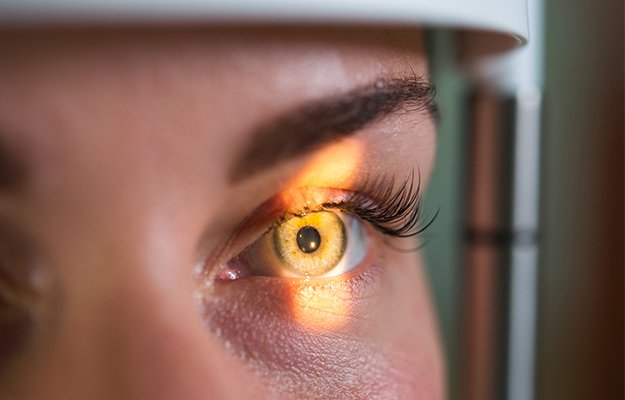Are you experiencing flashing lights, dark specks or thin lines moving in front of your field of vision as you move your eyes?
Floaters and flashes — two common age-related vision problems — are usually benign. Keep scrolling to learn about the basics of eye floaters and flashes, their symptoms, and what to do about them.

What Are Eye Floaters and Flashes?
Eye floaters and flashes are visual symptoms, usually associated with aging but they can also be an indication of a retina detachment. Floaters and flashes can be experienced simultaneously or separately.
What are eye flashes? As the name implies, eye flashes are seen as strands of light or sparks flickering in the vision field.
With eye floaters, you will see small particles or specs drifting and floating in front of the eye, particularly when looking at the sky or a blank space. The forms range from dark spots and ring shapes to transparent, squiggly strings.
What Causes Eye Floaters and Flashes?
Both eye floaters and flashes are caused by the natural shrinkage of the vitreous gel inside the eyeball.
Vitreous fluid is a thick, gel-like substance located between the retina and the lens in your eye. It’s mainly composed of water with a small number of collagen fibers, amino acids, sugars, proteins, and salts. The role of the vitreous gel is to maintain the shape of the eye and absorb shocks when you hit our head. It also ensures your retina stays attached to the back of the eye. It is a clear medium that allows light to pass through to the retina and thus allows you to see.
When we age, the consistency of the vitreous fluid can degrade or shrink over time. This can result in clumps or strands forming in the vitreous or the vitreous detaching from the retina. This is called a posterior vitreous detachment and is usually accompanied by floaters. When the vitreous is still attached to the retina but starts pulling on it, it will cause eye flashes.
Symptoms of Eyes Floaters and Flashes
Although people experience floaters differently, a lot of times, they are described as :
- Thread-like strands
- Squiggly lines
- Small shadow spots
- Black spots
With eye flashes, people describe them as:
- Lightening-like lines
- Bursts of lights that resemble camera flashes or fireworks
- Light streaks
- Bright spots
What Are the Risk Factors of Eye Flashes and Floaters?
Getting floaters or flashes is a common occurrence of aging. Some factors that might increase the risk of developing floaters and flashes are:
- Being over the age of 50
- Being diagnosed with diabetes
- Having a history of vision problems
- Having had cataract surgery
- Having myopia
- Having a detached or torn retina in the past
- The use of certain medication
- Having posterior eye inflammation
Light flashes and migraines
Sometimes, light flashes are caused by migraines. This is caused by spasms of the blood vessels in the brain. They can appear in 1 or both eyes and last up to 20 minutes. When accompanied by a headache, it’s called a migraine headache. When the light flashes occur without being followed by a headache, it’s called an ophthalmic migraine.
What to do with Eye Floaters and Flashes?

Seeing floaters and flashes is common as we age and is usually no problem. Your brain adapts, and you get used to them over time, so you won’t pay attention to them anymore.
Sometimes, they are very big and keep interfering with your vision. That might be a reason to have them surgically removed.
In any case, it is wise, with the sudden occurrence of new flashes and floaters or the sudden increase in the number of flashes and floaters, to have a check-up with your ophthalmologist.
When Are Flashes And Floaters More Serious?
Sometimes, they are indications of more serious conditions like retina detachment or a retina tear. This is a medical emergency. Consult an ophthalmologist right away if you have the following symptoms:
- A lot of new floaters
- A lot of new flashes
- Seeing a shadow or a curtain in your field of vision
Treatments for Floaters and Flashes
Flashes and floaters only require surgical intervention when they cause too many vision problems and reduce the quality of life or when they are symptoms of a retina tear or detachment. This is a medical emergency and requires prompt treatment.
The surgical procedure is called a vitrectomy, and it involves removing a part or all of the vitreous and replacing it with a medically-approved solution. Your eye will slowly replace this solution with newly produced vitreous.
Every patient deserves top-quality eye care from us. European Eye Center focuses on providing Western-standard services and determining appropriate treatment plans to help patients restore their vision in a feel-like-home atmosphere.
We are happy to help if you have questions about eye floaters and flashes. Don’t hesitate to connect with us at appointment@europeaneyecenter.com.
Contact us today to schedule an eye care service!







